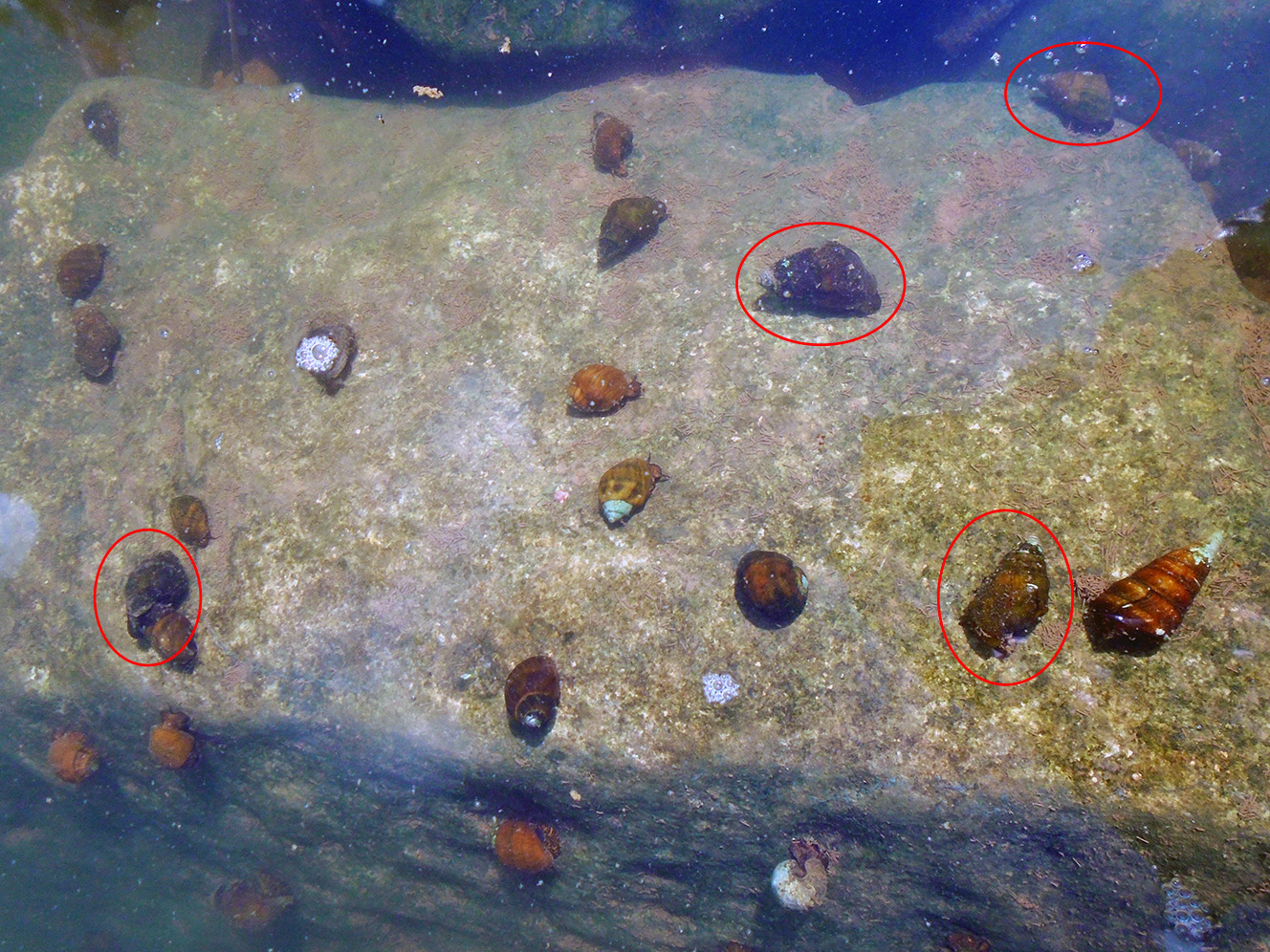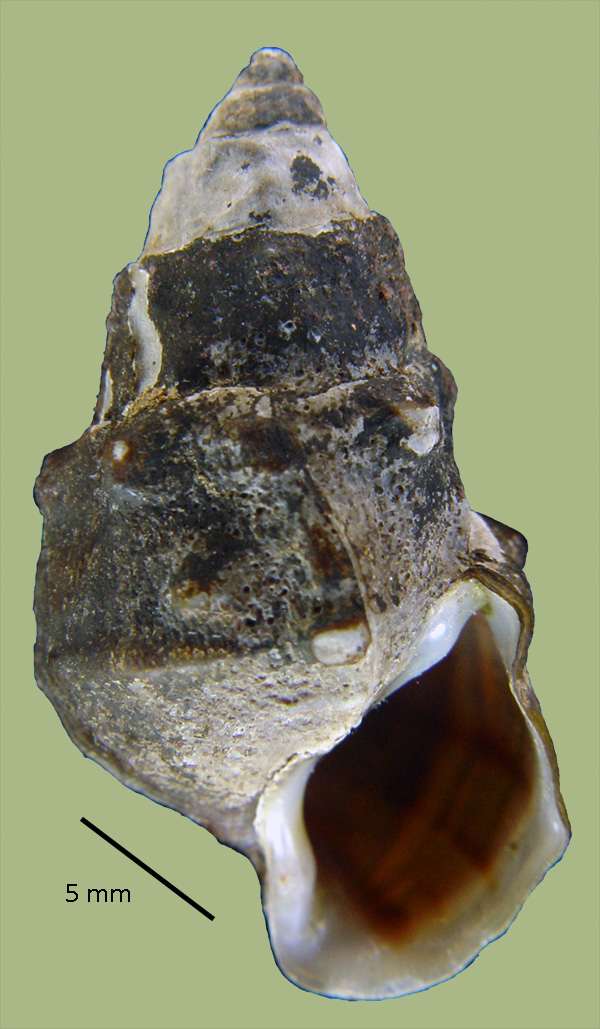> Habitat & Distribution
Goodrich (1940) considered populations of nominal Lithasia jayana endemic to their type locality, the Caney Fork of the Cumberland River. That entire river system was terribly impacted by the impoundment of the Center Hill Reservoir in 1948, apparently extincting the morphological form. Davis (1974) subsequently identified populations of Lithasia armigera jayana inhabiting the lower 60 miles of the Duck River of Middle Tennessee.
As is true for the genus generally, populations of L. armigera jayana reach maximum abundance grazing on solid substrates, especially on larger rocks in moderate currents. They are characteristic of large, rich, free-flowing rivers with broad riffles and good water quality. FWGNA incidence rank for all three subspecies combined I-4.
> Ecology & Life History
Pleurocerids are heavily-shelled, conspicuous freshwater gastropods, typically grazing nonspecifically on firm substrates in shallow waters. Males are aphallic; females can be distinguished by an egg laying groove on the right side of their foot. Most populations are perennial and iteroparous, typically requiring more than a year to mature and living several years (Life cycle Hi of Dillon 2000: 156-162). Eggs are affixed to hard substrates singly or in small clusters from spring to midsummer. Where present in high density, pleurocerids can have significant effects on energy flow in rivers and streams (Dillon 2000: 86-91).
> Taxonomy & Systematics
In his original (1841) description, Isaac Lea distinguished his Melania jayana from the more widespread Melania armigera (Say 1821) by the double row of tubercles, the armigera never possessing distinctly more than one row.
Angitrema armigera and Angitrema jayana were both among the 25 species in the genus Lithasia/Angitrema recognized by Tryon (1873), primarily inhabiting the Tennessee/ Cumberland but ranging throughout the interior drainages of seven states. Goodrich (1940) boiled these down to 10 species and 14 subspecies. Burch (1989) left Goodrich's system almost untouched, trimming out one species and 8 subspecies, but adding one species more recently described, to bring the total back to 10. Both Lithasia armigera and L. jayana survived this winnowing process unscathed.
Minton & Lydeard (2003) obtained mtDNA CO1 sequence data from 5 populations they identified as L. armigera: Ohio R (2 individuals), Wabash R (2), Tennessee R (1), Stones R (6), and Harpeth R (3). All 14 of these individuals were genetically indistinguishable. Minton & Lydeard did, however, document 4% divergence between their 14 Lithasia armigera CO1 sequences and a set of 19 sequences sampled from the Duck River of Middle Tennessee. The snails from which these 19 nearly-identical sequences were obtained were identified by five separate names on the basis of shell morphology: L. geniculata pinguis (6), L. geniculata fuliginosa (7), L. geniculata geniculata (1), L. jayana (1), and L. duttoniana (4). Minton & Lydeard suggested, therefore, that all five nomina be synonymized under Lithasia geniculata (Haldeman 1840). Minton et al. (2008, 2018) went on to lump all nominal taxa of Duck River Lithasia into combined studies of shell morphology.
The allozyme surveys of Dillon (2020), however, confirmed reproductive isolation between Duck River populations identified as L. geniculata (all subspecies) and those identified as L. duttoniana. No evidence of reproductive isolation was apparent between populations identified as L. duttoniana and L. jayana. See my 2022 series of essays from the links below.
In light of these results, we have suggested that both duttoniana (Lea 1841) and jayana (Lea 1841) be lowered to subspecific rank under Lithasia armigera (Say 1821). And we noted, as we did, that the shell morphological basis for distinctions such as these have often been attributable to cryptic phenotypic plasticity. See my 2013-14 essays on CPP from the links below to learn more about this important phenomenon.
> Maps and Supplementary Resources
- Lithasia distribution in the drainage of The Ohio (2019)
- Lithasia distribution in the Tennessee/Cumberland (2022)
- Five
species of
pleurocerids graze across this rock in the Duck River at the Watered
Hollow Boat Launch. Lithasia
armigera jayana encircled. Click for larger.

> Essays
- I proposed the concept of "cryptic phenotypic plasticity" in two essays on pleurocerid systematics, Pleurocera acuta is Pleurocera canaliculata (3June13) and Elimia livescens and Lithasia obovata are Pleurocera semicarinata (11July14). That latter essay featured a scan of Goodrich's historically-important figure of shell variation in Lithasia and Pleurocera.
- In 2016 I explored the phenomenon of extreme mtDNA heterogeneity within pleurocerid populations in a series of essays: Mitochondrial superheterogeneity: What we know, Mitochondrial superheterogeneity: What it means, and Mitochondrial superheterogeneity and speciation.
- In my essay of 4Jan22 I used my 2002 survey of allozyme variation in the Duck River Lithasia to answer the question, "What is character phase disequilibrium?" And on 3Mar22, I used the research of Minton & Lydeard (2003) on the Duck River Lithasia as an example of everything that can go wrong with so-called "DNA fingerprinting" in, "The third-most amazing research results ever published for the genetics of a freshwater gastropod population. And the fourth-most amazing, too." That 3March essay featured an image comparing Lithasia armigera duttoniana with Lithasia geniculata geniculata.
- On 28Mar22 I reported No reproductive isolation between Lithasia populations of the duttoniana and jayana forms in the Duck River, Tennessee. That essay featured a nice figure comparing the shell morphologies of both co-occurring forms.
- And on 5Apr22 I concluded my series with "The ham, the cheese, and Lithasia jayana." In that essay, I suggested that the duttoniana form and the jayana form should be considered subspecies of Lithasia armigera. See the striking images comparing all three subspecies of L. armigera scanned from Tryon (1873).
> References
Burch, J. B. (1989) North
American Freshwater Snails. Malacological Publications,
Hamburg, MI.
Davis, G.M. (1974) Report
on the rare and endangered status of a selected number of freshwater
Gastropoda from southeastern U.S.A. U.S. Fish & Wildlife
Service.
Washington, DC. 51 p.
Dillon, R.
T., Jr. (2000)
The Ecology of Freshwater Molluscs. Cambridge, Cambridge University
Press. 509 pp.
Dillon, R. T., Jr. (2011)
Robust shell phenotype is a local response to stream size in the genus Pleurocera.
Malacologia 53: 265-277. [pdf]
Dillon, R. T.,
Jr. (2014) Cryptic phenotypic plasticity in
populations of the North American freshwater gastropod, Pleurocera semicarinata.
Zoological Studies 53:31. [html] [pdf]
Dillon, R. T., Jr. (2020)
Reproductive isolation between Lithasia
populations of the geniculata
and duttoniana
forms in the Duck River, Tennessee. Ellipsaria 22(3): 6 -
8. [PDF]
Dillon, R. T., Jr., S. J.
Jacquemin & M. Pyron (2013) Cryptic phenotypic
plasticity in populations of the freshwater prosobranch snail, Pleurocera canaliculata.
Hydrobiologia 709: 117-127. [html] [pdf]
Goodrich, C. (1934)
Studies of the gastropod family Pleuroceridae - I. Occas.
Pprs. Mus. Zool. Univ. Mich. 286: 1 - 17.
Goodrich, C. (1940)
The Pleuroceridae of the Ohio River drainage system. Occas.
Pprs. Mus. Zool. Univ. Mich., 417: 1-21.
Goodrich, C. (1941)
Studies of the gastropod family Pleuroceridae VIII. Occas.
Pprs. Mus. Zool. Univ. Mich. 447: 1 - 13.
Holznagel, W. E.
& C. Lydeard (2000)
A molecular phylogeny of North American Pleuroceridae
(Gastropoda: Cerithioidea) based on mitochondrial 16S rDNA sequences.
Journal of Molluscan Studies 66: 233 - 257.
Minton, R. L. (2002)
A cladistic analysis of Lithasia
(Gastropoda: Pleuroceridae) using morphological characters.
The Nautilus 116: 39-49.
Minton, R. L., K. C.
Hart, R. Fiorillo, & C. Brown (2018)
Correlates of snail shell variation along a unidirectional
freshwater
gradient in Lithasia geniculata (Haldeman, 1840) (Caenogastropoda:
Pleuroceridae) from the Duck River, Tennessee, USA. Folia
Malacologica
26: 95 - 102.
Minton, R. L. &
C. Lydeard (2003) Phylogeny, taxonomy, genetics, and
global heritage ranks of an imperiled, freshwater snail genus Lithasia
(Pleuroceridae) Molecular Ecology 12: 75-87.
Minton, R. L., A. P.
Norwood & D. M. Hayes (2008) Quantifying
phenotypic gradients in freshwater snails: a case study in Lithasia
(Gastropoda: Pleuroceridae) Hydrobiologia 605: 173-182.
Tiemann, J. S., W. R.
Posey, K. S. Cummings, K. J. Irwin, and B. Turner (2013)
First occurrences of Lithasia
armigera and Lithasia
verrucosa (Gastropoda: Pleuroceridae) in the Mississippi
River. Southeastern Naturalist 12: N35 - N39.
Tryon, G. W. (1873)
Land and Fresh-water shells of North America. Part IV,
Strepomatidae. Smithsonial Miscellaneous Collections 253: 1-
434.








